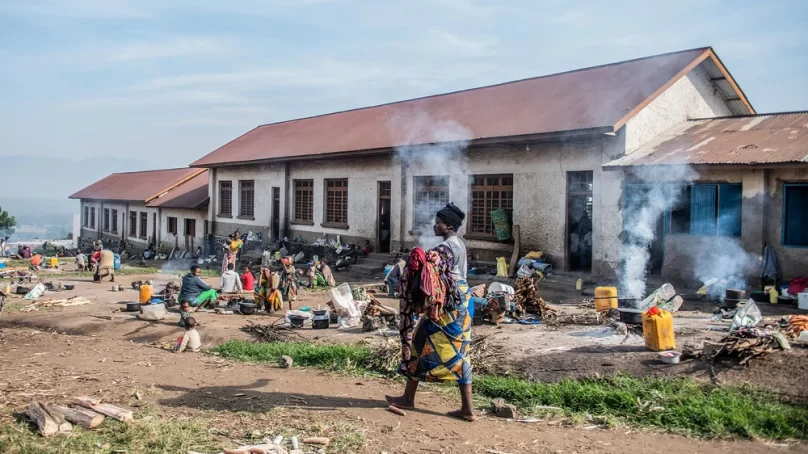
The return of a long dormant rebel group in eastern Democratic Republic of Congo (DRC) is overstretching an underfunded humanitarian relief operation and piling hardship onto communities that are already contending with dozens of other armed insurgencies.
For several months, the March 23 Movement (M23) rebel group has fought Congolese troops in North Kivu province. UN experts say its sights are set on Goma – a city of nearly two million people – though the group discounts this and has called for dialogue.
M23’s revival, almost ten years after it was thought defeated, has undermined regional stability. DRC accuses neighbouring Rwanda of backing the group, while a UN expert report states that individuals in Rwandan army uniforms were seen in M23 camps. Kigali denies the charge.
Civilians are facing the worst of the crisis, just as they did a decade ago: 170,000 have escaped their homes since late March, hundreds of children have been separated from their families, and hate speech is rising across the country.
“Every time there is a new rebellion, the civilian population pays the price,” said a man in his 30s who fled to North Kivu’s Rutshuru town and asked not to be named for security reasons. “These are political problems that need political solutions.”
We visited Rutshuru, the epicentre of the conflict, and Goma, North Kivu’s provincial capital, earlier this month. We spoke with displaced people, civil society leaders, aid workers, and officials from the M23 and Congolese army.
All offered different perspectives on the causes and consequences of the crisis, which presents a major test to President Félix Tshisekedi, whose government is based some 2,000 kilometres westward in the capital, Kinshasa.
Tshisekedi made security in the east a priority when he came to power in 2019. He has since imposed martial law; allowed Ugandan troops into the region to battle Islamist militants; and approved the deployment of an East African force.
Yet some 300 foreign and local armed groups remain active in eastern DRC – a legacy of the regional wars fought in the 1990s and 2000s. And even vanquished movements like the M23 are now bouncing back.
“We realise how weak this government is, and that Félix Tshisekedi’s leadership is non-existent,” said Aloys Tegera, a researcher at Pole Institute, a Goma-based think tank that specialises in conflict prevention and resolution.
“This [M23] crisis is adding to a worsening situation in eastern Congo. It comes on top of a series of other crises that we can’t forget in the region.”
In total, some 700,000 Congolese have been displaced this year, bringing the overall number of people uprooted in the country to nearly six million. The displacement crisis was the third biggest in the world in 2021, according to the Norwegian Refugee Council.
“This [M23] crisis is adding to a worsening situation in eastern Congo,” said Joseph Inganji, head of the UN’s emergency aid coordination agency (OCHA) in DRC. “It comes on top of a series of other crises that we can’t forget in the region.”
M23 led the last major rebellion in eastern DRC in 2012 and 2013. It seized chunks of North Kivu, including Goma, before the army and UN peacekeepers forced its fighters into Rwanda and Uganda, which were both accused of supporting the rebels.
The group is now asking Kinshasa to respect the terms of a 2013 accord that sketched plans for demobilisation and amnesty for its fighters. “Nothing that had been agreed has been implemented,” said M23’s spokesperson, Willy Ngoma, in a telephone interview.
Altshough details on the M23’s return to arms are hazy, the civilian toll of the crisis is clear. Many of the displaced in Rutshuru town are living in cramped public buildings and must contend with the regular thud of artillery fire echoing through nearby hills and forests.
“We pray that the war will end, and that we will come out of it alive.”
Access to water and other basic services is scarce in the camps, while displaced people they had not received any food aid for the past two months. Some were begging local residents for supplies.
“Sometimes people are generous, sometimes we stay hungry,” said Jean de Dieu Iyakaremye, a teacher and father of four living at a camp in a sports stadium in Rutshuru. “We pray that the war will end, and that we will come out of it alive.”
Thousands of Congolese have also escaped to Uganda, but conditions there are “very bad”, said Anuarite Kanyere, a mother of six from Bunagana, an M23-occupied town and cross-border trading hub.
Kanyere left for Uganda in March – carrying a four-day-old baby – but returned to DRC soon after. “I hoped we would be able to get some help here,” she said from a camp at a school in Rutshuru town. “But there is nothing.”
Displaced people from different villages in eastern DRC’s North Kivu province have moved to a primary school in Rutshuru town. Access to water and other basic services is scarce at the site.
Displaced children, who constitute half of the total number uprooted, are facing particular challenges. Many have been separated from their families after escaping towns and villages in chaotic circumstances.
Aline Mwavita, a 15-year-old girl, said she and her 5-year-old brother were working in fields near their family home in Rutshuru territory when they heard explosions and gunfire drawing closer.
“We ran back home but our parents had already fled,” Mwavita narrated. “They didn’t even take the time to put the padlock on the door.”
Both children are now living with a host family in Rutshuru town, but the 5-year-old is struggling. A local social worker said the boy can’t stop talking about sheep he lost when fleeing the rebels. He worries his parents will rebuke him when they are reunited.
- The New Humanitarian report











